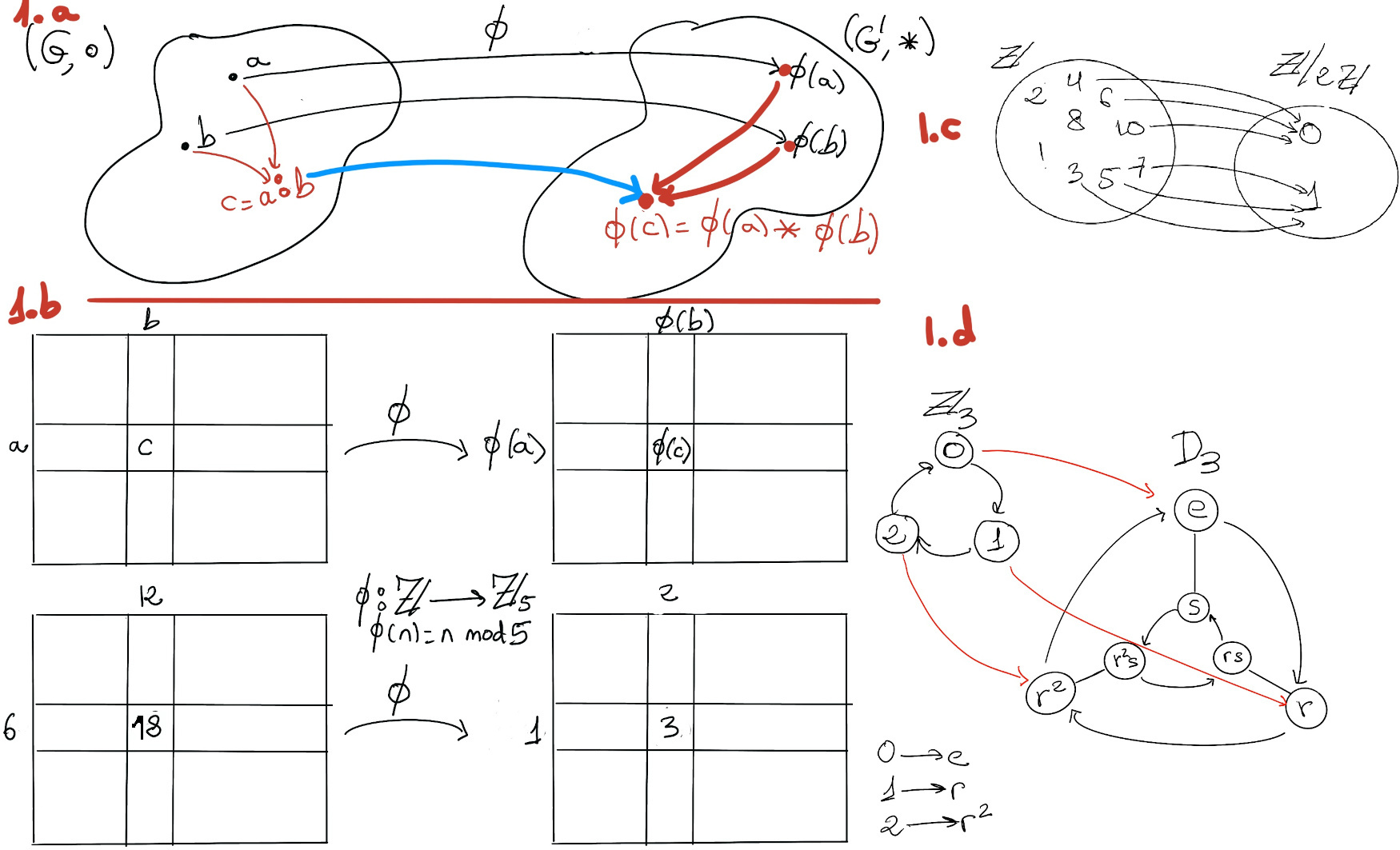
|
 |
 |

|
 |
 |
“Now, at last, I understand the general theory of relativity. Hours seem like minutes or even seconds when I am with you.” “Your futile attempt at flirting with me is hereby acknowledged,” Susanne retorted… Apocalypse, Anawim, #justtothepoint.
A homomorphism Φ from a group G to a group G’ is a function or a mapping from (G, ∘) to (G', *) that preserves the operations of the groups; this means a map, Φ: G → G’ between both groups that satisfies Φ(a∘b) = Φ(a)*Φ(b) for every pair a, b of elements of G, that is, ∀a, b ∈ G.


⇒) Suppose Φ is injective.
∀g ∈ Ker(Φ) ⇒ Φ(g) = e’ =[Φ carries the identity] Φ(e) ⇒ [By assumption, Φ is injective] g = e ⇒ Ker(Φ) = {e}.
⇐) Suppose ker(Φ) = {e}.
∀g, g’ ∈ G: Φ(g) = Φ(g’) ⇒ Φ(g)(Φ(g’))-1 = e’ ⇒[Φ(an) = (Φ(a))n] Φ(g)Φ(g’-1) = e’ ⇒ Φ(g·g’-1) = e’ ⇒[By assumption, ker(Φ) = {e}] g·g’-1 = e ⇒ g = g’∎
Example. Let Φ: (ℝ*, ·) → (ℝ*, ·), Φ(x) = x^r, r > 0. Φ(xy) = (xy)r = xryr = Φ(x)Φ(y) ⇒ Φ is a homomorphism. Φ(x) = xr = 1 ⇒ If r is even, Ker(Φ) = {-1, 1}. If r is odd, Ker(Φ) = {1}.
This follows directly from the definition of an n-to-1 mapping (An n-to-1 mapping from G onto Φ(G) means that ∀g ∈ G, there exist n elements in G which maps to Φ(g) = g’). Recall the previously proven property (If Φ(g) = g’, Φ-1(g’) = gKer(Φ)) and the fact that all cosets of Ker(Φ) have the same number of elements, so there are |Ker(Φ)| = n elements of G -H = Ker(Φ), all cosets of Ker(Φ) has n elements, the cardinality of the identity coset eH = H- which maps to Φ(g) = g'.
Let’s denote ΦH the homomorphism of Φ restricted to the elements of the subgroup H ⇒ By the previous property, ΦH is a |Ker(ΦH)|-to-1 mapping from H onto ΦH(H) ⇒ |H| = n = |Φ(H)||Ker(ΦH)| ⇒ |Φ(H)| divides n.
Proof.
e ∈ Φ-1(K) because Φ(e) = e’ ∈ K (K ≤ G).
Let k1, k2 ∈ Φ-1(K), k1k2-1 ∈ Φ-1(K)?
Φ(k1k2-1) = Φ(k1)Φ(k2-1) = Φ(k1)(Φ(k2))-1 ∈ K (K ≤ G’, Φ(k1), Φ(k2) ∈ K) ⇒ k1k2-1 ∈ Φ-1(K) ∎
Proof. (We have already proved that Φ-1(K) ≤ G)
Suppose K ◁ G’. ∀x ∈ G, k ∈ Φ-1(K), xkx-1 ∈ Φ-1(K)?
Φ(xkx-1) = Φ(x)Φ(k)Φ(x-1) = Φ(x)Φ(k)(Φ(x))-1 ∈ K (By assumption, K ◁ G’ and k ∈ Φ-1(K) ⇒ Φ(k) ∈ K) ∎
If Φ is homomorphism (operation-preserving mapping), onto and Ker(Φ) = {e}, we only need to prove that is one-to-one.
We already know that if |Ker Φ| = n, then Φ is an n-to-1 mapping from G onto Φ(G) ⇒ Ker(Φ) = {e}, |Ker Φ| = 1, then Φ is a one-to-one mapping from G to G’ ∎
Let’s compute all the elements that map to 2. Obviously, $Φ(\sqrt[4]{2}) = 2$ ⇒ [Φ(a) = Φ(b) if and only if aKer(Φ) = bKer(Φ)] $Φ(\sqrt[4]{2})Ker(Φ) = $ $Φ(\sqrt[4]{2})({1, -1, i, -i})$ = {$\sqrt[4]{2}, -\sqrt[4]{2}, \sqrt[4]{2}i, -\sqrt[4]{2}i$} are all elements that map to 2.
Let H = ⟨cos30° + i sin30°⟩ ⇒ [de Moivre’s theorem, (cosx + i·sinx)n = cosnx + isinnx, 12*30=360, so there are 12 elements in the unit circle] |H| = 12 ⇒ [If H is cyclic ⇒ Φ(H) is cyclic. If |H| = n ⇒ |Φ(H)| divides n] Φ(cos30° + i sin30°) =[By definition of Φ, de Moivre’s theorem] cos120° + i·sin120°, Φ(H) = ⟨cos120° + i·sin120°⟩ and Φ(H) has order 3, and obviously 3 | 12, that is, |Φ(H)| | |H|.
Φ(2) = 6 ⇒ [Φ-1(a’) = {x ∈ G | Φ(x) = a’} =say a ∈ Φ-1(a’) aKer(Φ)] Φ-1(6) =[Additive notation] 2 + Ker(Φ) = 2 + {0, 4, 8} = {2, 6, 10}. In words, 💡 Φ is a 3-to-1 mapping, so there are three distinct elements in the domain (2, 6, 10) that map to the same element in the codomain (6).
⟨2⟩ is cyclic ⇒ [If H is cyclic ⇒ Φ(H) is cyclic] ⟨Φ(2)⟩ is cyclic. Besides, ⟨Φ(2)⟩ = ⟨6⟩ = {0, 6}, and |Φ(2)| = |⟨Φ(2)⟩| = 2 divides |⟨2⟩| = 6 (Recall: If |H| = n ⇒ |Φ(H)| divides n).
Analogously ⟨1⟩ and ⟨3⟩ are cyclic, Φ(1) = 3, Φ(3) = 9, Φ-1(3) = 1 + Ker(Φ) = 1 + {0, 4, 8} = {1, 5, 9}. Φ-1(9) = 3 + Ker(Φ) = 3 + {0, 4, 8} = {3, 7, 11}.
Conversely, let K = {0, 6} ≤ ℤ12 ⇒ [If K is a subgroup of G', then Φ-1(K) = {k ∈ G: Φ(k) ∈ K} is a subgroup of G] Φ-1(K) = {0, 2, 4, 6, 8, 10} ≤ ℤ12
Ker(Φ) ≤ ℤ12, |ℤ12/Ker(Φ)| = 12/3 = 4, so ℤ12 has 4 cosets, namely Ker(Φ) ∪ 1 + Ker(Φ) ∪ 2 + Ker(Φ) ∪ 3 + Ker(Φ) where Ker(Φ) = {0, 4, 8}, 1 + Ker(Φ) = {1, 5, 9}, 2 + Ker(Φ) = {2, 6, 10}, and 3 + Ker(Φ) = {3, 7, 11}.
∀n ∈ ℤ, Φ(an) = (Φ(a))n, therefore in addition notation, Φ(na) = nΦ(a). In other words, ∀n ∈ ℤ, Φ(n) = nΦ(1), that is, since there is a generator in the domain, namely 1, each homomorphism is completely specified by its image.
If |a| is finite, then |Φ(a)| divides |a| ⇒ |Φ(a)| divides |a| and also by Lagrange, 7. Besides, by Lagrange |a| needs to divide 12. Therefore, |Φ(a)| needs to divide 7 and 12 ⇒[gcd(7, 12) = 1] |Φ(a)| = 1, there is only one homomorphism, the trivial homomorphism.
Another way of seeing it. Φ(12) = Φ(0) = 0, and Φ(12) = 12·Φ(1) ≡ 0 (mod 7). Since 12 is relatively prime to 7 ⇒ Φ(1) = 0 ⇒ Φ(n) = n·Φ(1) ≡ 0 (mod 7) ∀n ∈ ℤ12.
∀n ∈ ℤ, Φ(an) = (Φ(a))n, therefore in addition notation, Φ(na) = nΦ(a). In other words, ∀n ∈ ℤ, Φ(n) = nΦ(1), that is, since there is a generator in the domain, namely 1, each homomorphism is completely specified by its image.
If |a| is finite, then |Φ(a)| divides |a| ⇒ |Φ(a)| divides |a| and also by Lagrange, 30. Besides, by Lagrange |a| needs to divide 12. Therefore, taking into consideration both constraints, |Φ(1)| = 1, 2, 3, or 6, then we can calculate all candidates for the distinct homomorphisms.
If |Φ(1)| = 4, then |Φ(1)| divides 12, but does not divide 30 (⊥).
Suppose for the sake of contradiction there exist non-trivial homomorphism, |Im(Φ)| = 2, ∃σ ∈ A4: Φ(σ) = 1. We also know that Ker(Φ) ◁ A4.
Then, Φ-1(1) = σKer(Φ) is a coset of the kernel ⇒ Therefore, σKer(Φ) and Ker(Φ) are two left cosets, and form a partition of A4 (Φ-1(0) = Ker(Φ), Φ-1(1) = σKer(Φ)). Finally, |A4/Ker(Φ)| = 2 = 12/|Ker(Φ)| ⇒ |Ker(Φ)| = 6 ⊥ Ker(Φ) is a subgroup of A4 of order 6, but A4 does not have a subgroup of order 6.